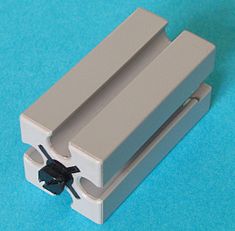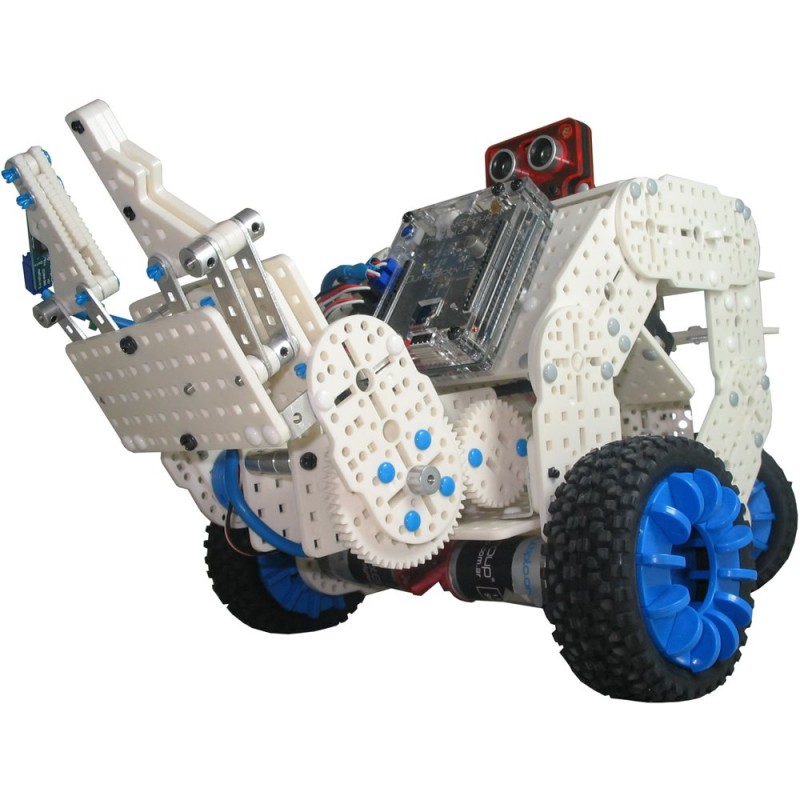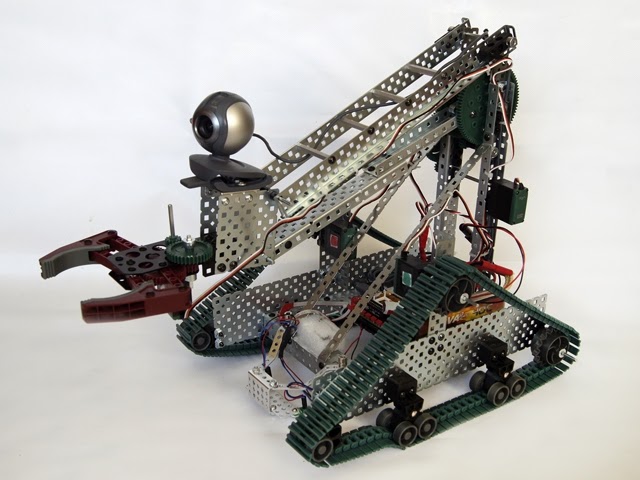Overview of glands for practicing robotics with children - 2
Under the cut, we tried to somehow generalize and systematize our experience in choosing a platform for classes with children. If you are organizing a robotics circle, it may be useful for you.
To the last series there were a lot of fair comments, on this occasion I completely reworked the material.
Platforms for creating robots, as a rule, include the following components:
Platforms are closed (Lego, Fischertechnik) and open (Arduino, Multiplo), you can also select intermediate options (Huna). The property of closed ones is that their components are poorly compatible with other platforms, and very rarely there are lovers, for example, hooking up to some separate sensors to Lego; Therefore, it makes sense to consider closed platforms entirely; for open ones, we will consider each of the four components listed above separately.
First lyrical digression.
At one time, I was one of the happiest children in Yekaterinburg, because my father brought me a whole Lego suitcase from Germany (at that time it was still very small in Russia). And I think this has a great impact on my mental development - fine motor skills, spatial thinking. However, people have such a property: when they grow up, they sometimes begin to dislike the environment from which they came out, and so they often reproach me with bias towards Lego. Now I still try to overcome it.
')

So, the main advantage of Legovsky mechanics is the speed of assembly. Probably, it is ten times higher than on screws, twice as high as on rivets. By and large, the main connecting element of Lego Technic is the same rivet that does not need to be clamped, it opens itself at the expense of elasticity:

The second element is an axis with a cross-section:

In fact, this is a screw substitute, only the “nuts” do not twist on it, but are held by longitudinal friction.
Plus, Lego has special parts for assembling some specific components, for example, a differential. All this allows you to quickly assemble very complex mechanisms, and for children it is really great. It’s a pity that we are not children forever, and then a problem arises: in adult life such compounds are not used anywhere, and nobody has yet realized a smooth transition from Lego to something else, as far as I know. In addition, another trouble arises, which I myself had encountered when I was growing up: in Lego everything fit out of the box is perfect, up to microns, the child gets used to it, takes it for granted. In reality, for such accuracy it is necessary to put enormous effort, and I have been studying for a long time as a student, it seems, so far I have not really learned.
Lego's control module is boring.

On the one hand, it is very durable, almost does not break, on the other hand it has only 8 connectors and nothing fits there except for branded Lehov wires (by the way, as far as I know, the most fragile part). Of course, only Legov's sensors and motors work with him regularly.
From the teacher's point of view, Legovskaya electronics is the most ill-fangled: everything connects easily, almost never breaks anything, however there is very little room for creativity.
Since Lego is a big company, it took care of the infrastructure: the overwhelming number of robotics competitions have a limitation - only Lego.

In addition, there are many different conferences and events for teachers.
The summary is as follows: the thing is incredibly cool, it really is, however, as for all toys, the sooner the child jumps off of it, the better, in our experience, the seventh grade is just right. Lego is also the only designer who does not require serious technical training from a teacher. Well, even by its ideology, it is very similar to Microsoft, some Microsoft do not like.
habrahabr.ru/company/neuronspace/blog/243929

If I understand correctly, the following story happened to this designer: Lego very successfully patented its connections andAlan Arthur Fisher had no choice but to use some kind of connection that is not very suitable for these purposes (it seems, “dovetail” it is called).

For this reason, some simple mechanisms on Fischertechnik are not very convenient to do, but there are a lot of special elements with which you can do absolutely incredible things: pneumatic drives, chemotronics, ionistors, electrochemical supercapacitors, etc. (for more, see the link above). In addition, there are specialized kits that simulate a particular production.
In general, the ideology of Fischertechnik repeats the ideology of Lego, after all, it is a toy, but very technically advanced.
First, some terminology. All peripheral electronics for adult robotics have standard connectors, working according to standard protocols. Fischertechnik, Lego and other closed products create artificial barriers to connecting through these connectors and protocols. Products are simpler, for example, Raspberry, although they are not open source, but all standards support. In general, in our experience, in this case, the openness of iron does not matter so much: all connectors are standard, development environments are standard and, as a rule, open-source, and the iron gasket between them does not play a significant role, switching to another piece of hardware will not cause any problems. Here you can still talk about our mission for the development of open-source iron, but for brevity we omit it, the topic is not very relevant.
So, the control modules can be divided into 2 categories: arduino-like (with a simple controller) and Rapberry-like (with a full-fledged Linux on board).
Advantages of Arduino:
The advantage of Raspberry is that it is a full-fledged Linux, thanks to this all popular programming languages are supported, you can start parallel processes, run them on the crown, connect different devices via USB, run different software, for example, to process an image, there is a web server, in short , a complete set of Isthnik's joy out of the box. Separately, I note the support of the language Python. This is the most promising educational programming language in the West, educational institutions are gradually translating their curricula into it, C ++ in education is the last century.
Compared with its counterparts, Raspberry is the most common and cheap; according to its characteristics, the latest version of its counterparts is not inferior to anything, so we work with it.

Among arduin we chose Uno, because, again, the most common and cheap (in China costs about 30 yuan or ~ 300 rubles). Her characteristics are not the most, but we seem to be missing.

The direction we are working on is the combination of Raspberry and Arduin, it seems to us the most promising. The following options exist:
Separately mention the controller Trick :

It seems like the only domestic development. It already has built-in motor drivers, and various sensors. Stuck cool, but really very expensive.
There are three main areas of work of children in the field of robotics:
We work with Multiplo .

First, it seems to be the only open source. Secondly, cheap. Thirdly, the main parts can be cut yourself with a jigsaw and drill.
Of the other designers, Huna is the most popular (by the way, the Russian development seems to be partly):

Trick offers a good designer, but, again, very expensive.

The general principle of all designers is about the same: the flat parts and the corners are connected with screws, in fact, the old Soviet iron constructor. In addition, each has its own characteristics: in the Multiplo, the main parts are cut from three-millimeter plastic + small aluminum corners + plastic rivets; in Huna, flat metal is complemented with bulky plastic parts similar to Lego; The trick is just very massive.
Our choice is Arduino + Raspberry + Multiplo. The price is the lowest, the largest scope for creativity. At the same time, very high qualifications are required from the teacher.
In general, we work with children from the third grade, but this is rather an exception, after all, until the seventh grade, something else is needed, such as Lego or Fischertechnik.
To the last series there were a lot of fair comments, on this occasion I completely reworked the material.
Introduction
Platforms for creating robots, as a rule, include the following components:
- Mechanics;
- peripheral electronics;
- control module;
- software (development environment).
Platforms are closed (Lego, Fischertechnik) and open (Arduino, Multiplo), you can also select intermediate options (Huna). The property of closed ones is that their components are poorly compatible with other platforms, and very rarely there are lovers, for example, hooking up to some separate sensors to Lego; Therefore, it makes sense to consider closed platforms entirely; for open ones, we will consider each of the four components listed above separately.
Lego
First lyrical digression.
At one time, I was one of the happiest children in Yekaterinburg, because my father brought me a whole Lego suitcase from Germany (at that time it was still very small in Russia). And I think this has a great impact on my mental development - fine motor skills, spatial thinking. However, people have such a property: when they grow up, they sometimes begin to dislike the environment from which they came out, and so they often reproach me with bias towards Lego. Now I still try to overcome it.
')

So, the main advantage of Legovsky mechanics is the speed of assembly. Probably, it is ten times higher than on screws, twice as high as on rivets. By and large, the main connecting element of Lego Technic is the same rivet that does not need to be clamped, it opens itself at the expense of elasticity:

The second element is an axis with a cross-section:

In fact, this is a screw substitute, only the “nuts” do not twist on it, but are held by longitudinal friction.
Plus, Lego has special parts for assembling some specific components, for example, a differential. All this allows you to quickly assemble very complex mechanisms, and for children it is really great. It’s a pity that we are not children forever, and then a problem arises: in adult life such compounds are not used anywhere, and nobody has yet realized a smooth transition from Lego to something else, as far as I know. In addition, another trouble arises, which I myself had encountered when I was growing up: in Lego everything fit out of the box is perfect, up to microns, the child gets used to it, takes it for granted. In reality, for such accuracy it is necessary to put enormous effort, and I have been studying for a long time as a student, it seems, so far I have not really learned.
Lego's control module is boring.

On the one hand, it is very durable, almost does not break, on the other hand it has only 8 connectors and nothing fits there except for branded Lehov wires (by the way, as far as I know, the most fragile part). Of course, only Legov's sensors and motors work with him regularly.
From the teacher's point of view, Legovskaya electronics is the most ill-fangled: everything connects easily, almost never breaks anything, however there is very little room for creativity.
Since Lego is a big company, it took care of the infrastructure: the overwhelming number of robotics competitions have a limitation - only Lego.

In addition, there are many different conferences and events for teachers.
The summary is as follows: the thing is incredibly cool, it really is, however, as for all toys, the sooner the child jumps off of it, the better, in our experience, the seventh grade is just right. Lego is also the only designer who does not require serious technical training from a teacher. Well, even by its ideology, it is very similar to Microsoft, some Microsoft do not like.
Fischertechnik
habrahabr.ru/company/neuronspace/blog/243929

If I understand correctly, the following story happened to this designer: Lego very successfully patented its connections and

For this reason, some simple mechanisms on Fischertechnik are not very convenient to do, but there are a lot of special elements with which you can do absolutely incredible things: pneumatic drives, chemotronics, ionistors, electrochemical supercapacitors, etc. (for more, see the link above). In addition, there are specialized kits that simulate a particular production.
In general, the ideology of Fischertechnik repeats the ideology of Lego, after all, it is a toy, but very technically advanced.
Cross-platform control modules
First, some terminology. All peripheral electronics for adult robotics have standard connectors, working according to standard protocols. Fischertechnik, Lego and other closed products create artificial barriers to connecting through these connectors and protocols. Products are simpler, for example, Raspberry, although they are not open source, but all standards support. In general, in our experience, in this case, the openness of iron does not matter so much: all connectors are standard, development environments are standard and, as a rule, open-source, and the iron gasket between them does not play a significant role, switching to another piece of hardware will not cause any problems. Here you can still talk about our mission for the development of open-source iron, but for brevity we omit it, the topic is not very relevant.
So, the control modules can be divided into 2 categories: arduino-like (with a simple controller) and Rapberry-like (with a full-fledged Linux on board).
Advantages of Arduino:
- Low price.
- Quick start: stuck a USB-wire, opened the development environment, downloaded the example, let's go. With Raspberry you will have to suffer even more: download the image to the card, connect, configure scripts to start up automatically, etc.
- It is more convenient to connect peripherals (for example, the board already has analog inputs, it is difficult to connect to the Raspberry ADC), a large number of different types of shields.
- Low power consumption.
The advantage of Raspberry is that it is a full-fledged Linux, thanks to this all popular programming languages are supported, you can start parallel processes, run them on the crown, connect different devices via USB, run different software, for example, to process an image, there is a web server, in short , a complete set of Isthnik's joy out of the box. Separately, I note the support of the language Python. This is the most promising educational programming language in the West, educational institutions are gradually translating their curricula into it, C ++ in education is the last century.
Compared with its counterparts, Raspberry is the most common and cheap; according to its characteristics, the latest version of its counterparts is not inferior to anything, so we work with it.

Among arduin we chose Uno, because, again, the most common and cheap (in China costs about 30 yuan or ~ 300 rubles). Her characteristics are not the most, but we seem to be missing.

The direction we are working on is the combination of Raspberry and Arduin, it seems to us the most promising. The following options exist:
- Integrating Arudino connectors into a board similar to Raspberry ( for example ). Thus, Raspberry loses its disadvantage the inconvenience of connecting external devices.
- Connect to the original Raspberry special adapter with arduino connectors ( for example ). This gives the same advantages as in the previous paragraph, plus additional flexibility appears to this: you can detach this adapter and use the original Raspberry connectors (rarely, but it is also more convenient with them). In addition, if one board burns, it does not hurt to continue using the other.
- Integrating Raspberry processor, arduino processor and connectors into one board (http://www.udoo.org/). In addition to the advantages of the preceding paragraphs, such a scheme offers the advantages of a dual-processor circuit; some things on it are much more convenient to do.
- A special Arduino board that has a connector for connecting to a Raspberry (for example, Arduberry ). In addition to the advantages of the preceding paragraph, this gives flexibility.
- Connect arduina to Raspberry via USB. Not as convenient as the previous version, the data transfer rate is lower, but much cheaper. Actually this is what we are working on now.
Separately mention the controller Trick :

It seems like the only domestic development. It already has built-in motor drivers, and various sensors. Stuck cool, but really very expensive.
Constructors
There are three main areas of work of children in the field of robotics:
- Build electrical circuits with a microcontroller. Corresponding kits are supplied, for example, by Ampere: wiki.amperka.ru
- Assembly and programming of the simplest machines, like this: amperka.ru/product/turtle-chassis . Basically, these cars are engaged in driving on the drawn line (linelight).
- Assembling more complex mechanisms from the designers, they will be discussed further.
We work with Multiplo .

First, it seems to be the only open source. Secondly, cheap. Thirdly, the main parts can be cut yourself with a jigsaw and drill.
Of the other designers, Huna is the most popular (by the way, the Russian development seems to be partly):

Trick offers a good designer, but, again, very expensive.

The general principle of all designers is about the same: the flat parts and the corners are connected with screws, in fact, the old Soviet iron constructor. In addition, each has its own characteristics: in the Multiplo, the main parts are cut from three-millimeter plastic + small aluminum corners + plastic rivets; in Huna, flat metal is complemented with bulky plastic parts similar to Lego; The trick is just very massive.
Conclusion
Our choice is Arduino + Raspberry + Multiplo. The price is the lowest, the largest scope for creativity. At the same time, very high qualifications are required from the teacher.
In general, we work with children from the third grade, but this is rather an exception, after all, until the seventh grade, something else is needed, such as Lego or Fischertechnik.
Source: https://habr.com/ru/post/252015/
All Articles